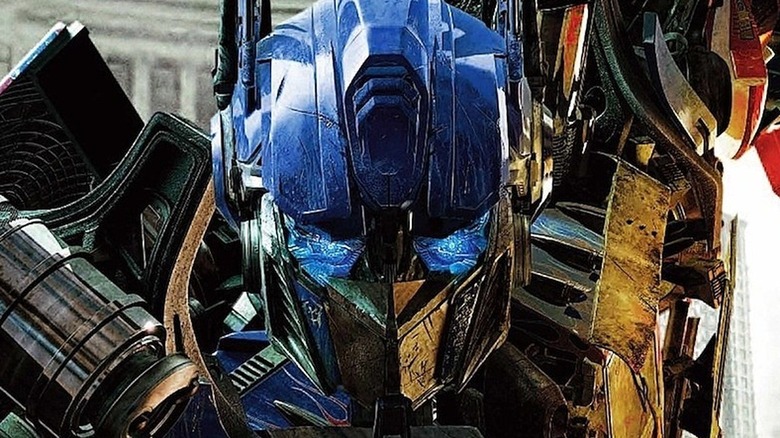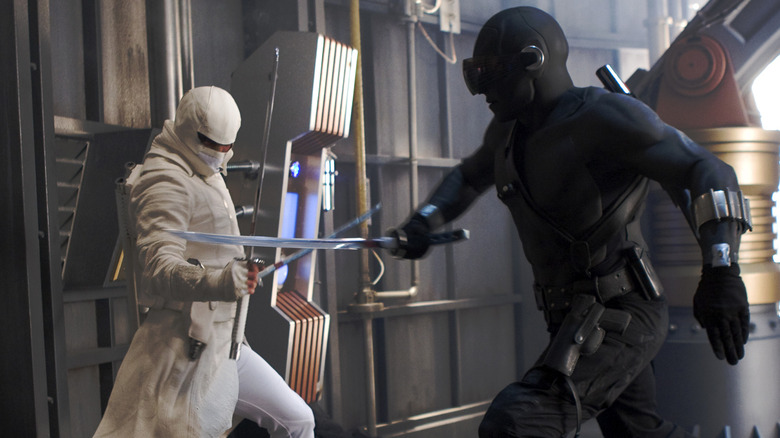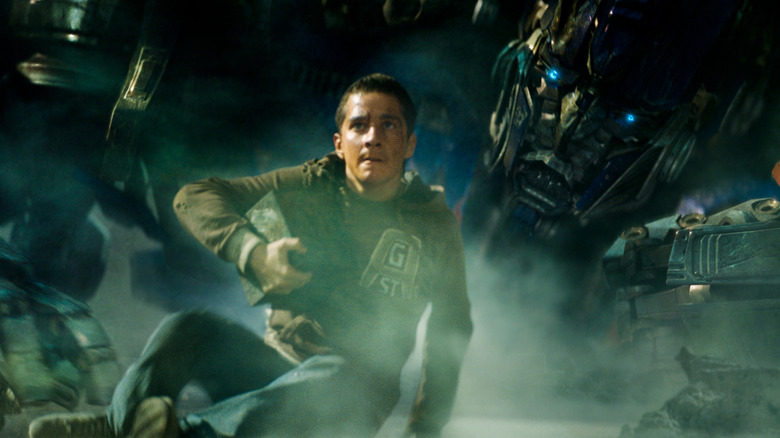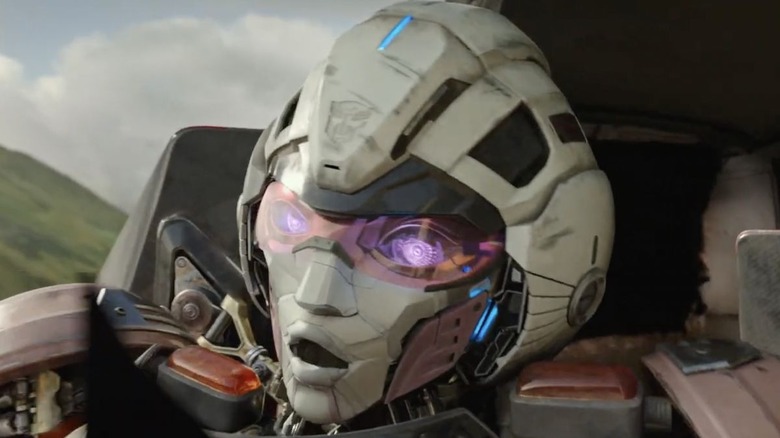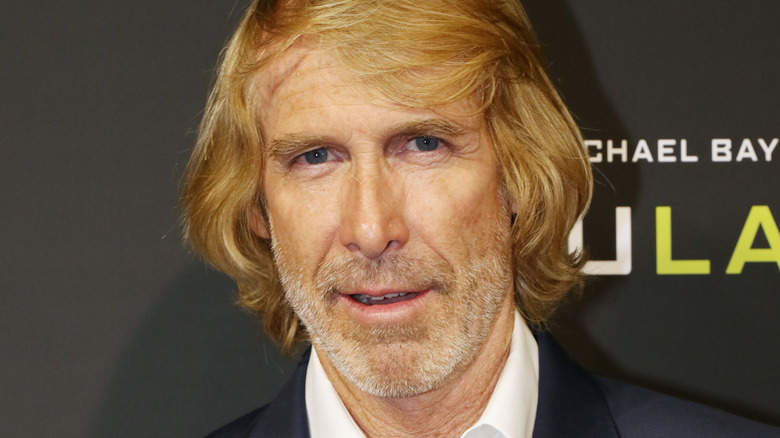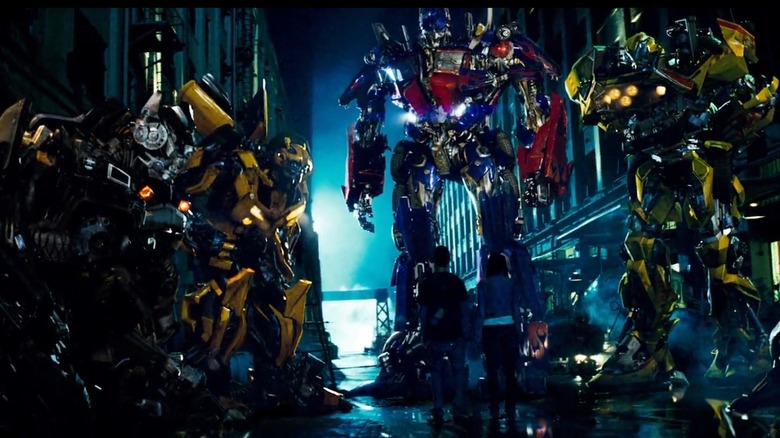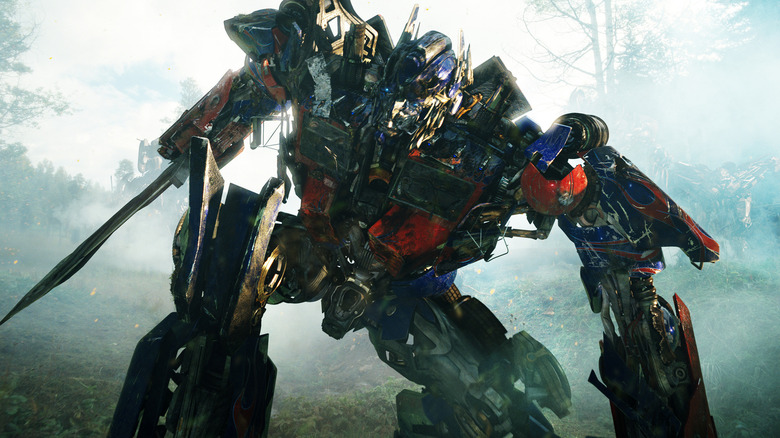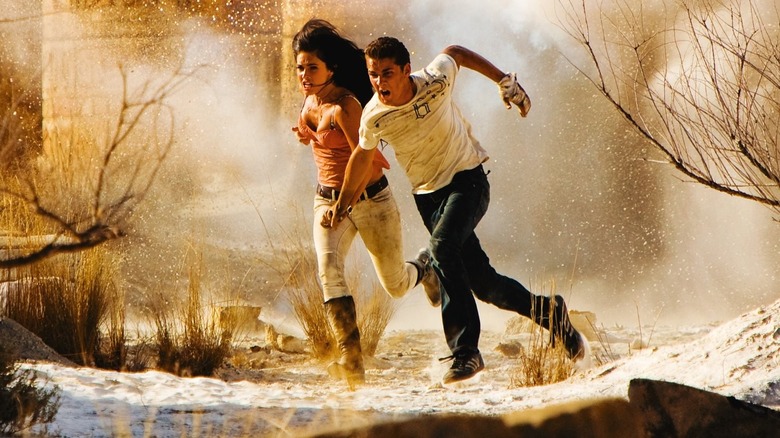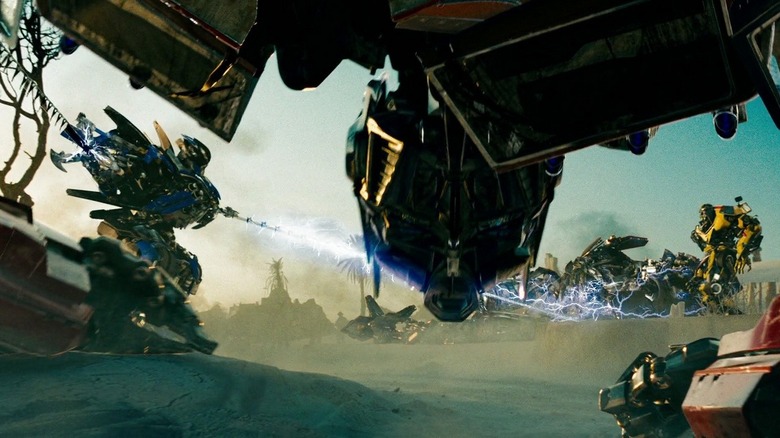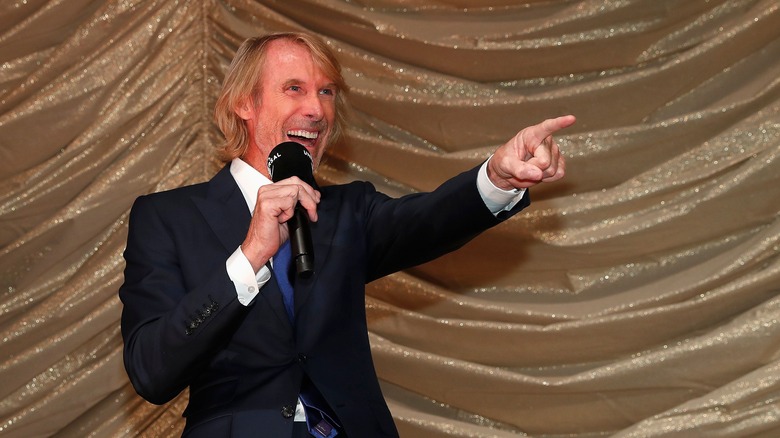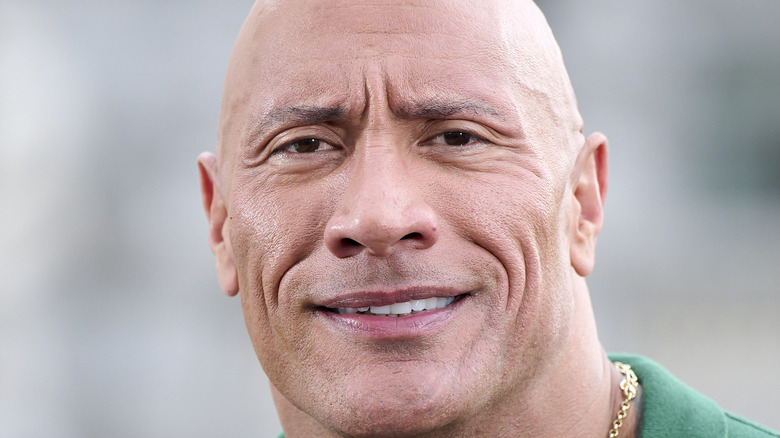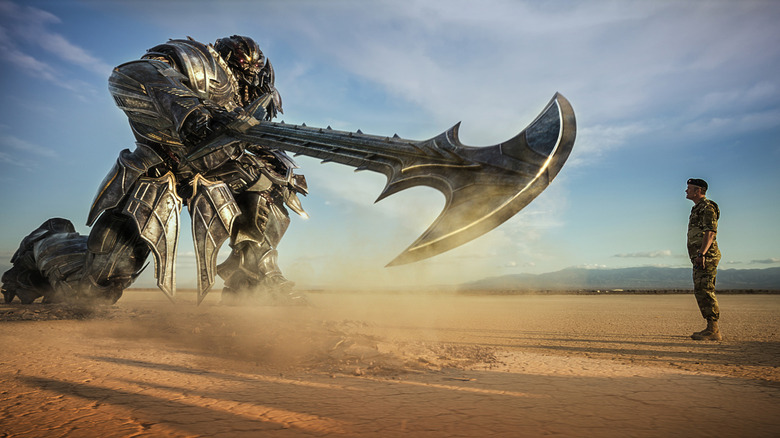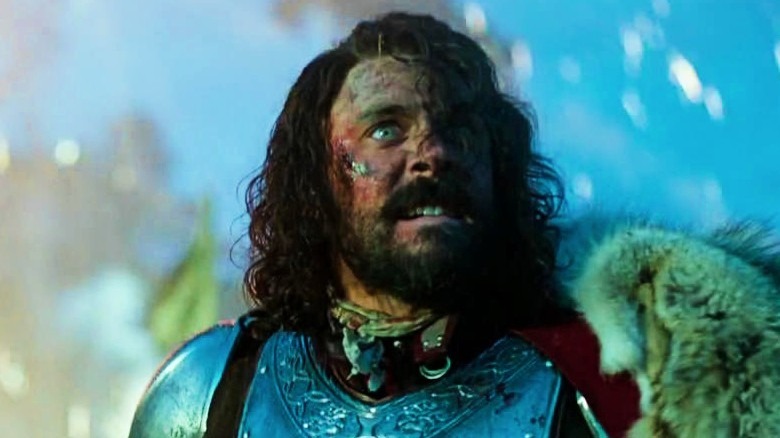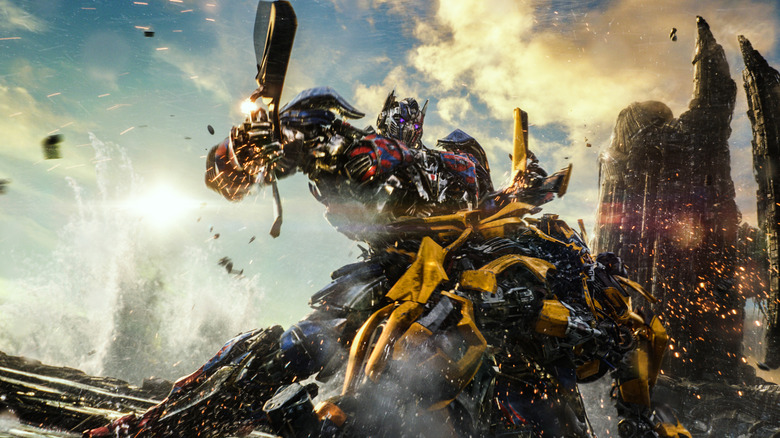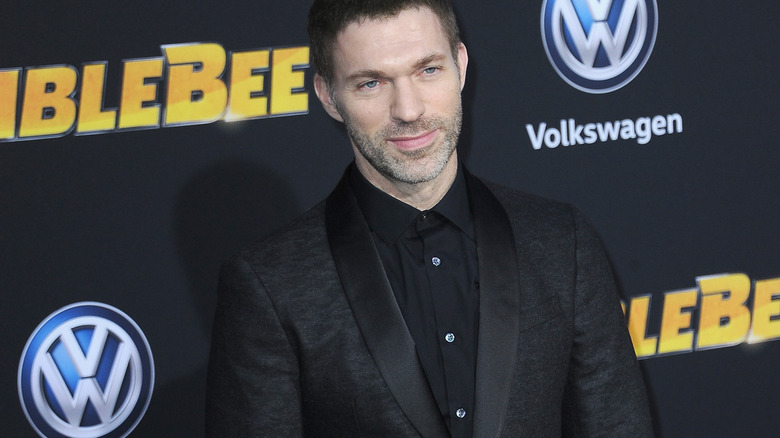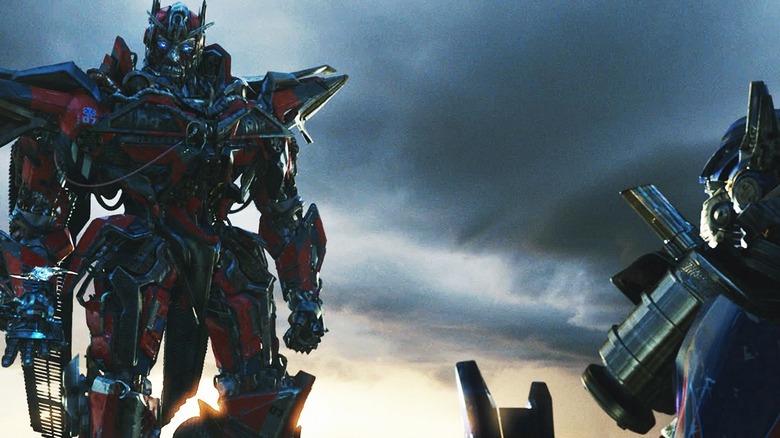Transformers Franchise Facts Cooler Than A Morphing Car
The "Transformers" pop culture property has been around since the 1980s, so it's no surprise that the live-action adaptation of those robots in disguise has also lasted a good long while. Starting in 2007 with "Transformers," the "Transformers" movies have currently spanned six live-action features and don't appear to be stopping anytime soon thanks to new installments penciled in as big blockbusters in 2023 and 2024. It'd be an understatement to say that these "Transformers" movies have had some questionable moments, but they've also proven consistently lucrative. People keep showing up to see these robots duke it out on the biggest screen imaginable, in the process lengthening the lifespan of the entire "Transformers" mythology.
Though it can be easy to dismiss the "Transformers" movies as nothing but exhaust fumes and punching (which isn't an entirely inaccurate assessment), there's still a lot of thought that's gone into these motion pictures. This collection of facts about the "Transformers" franchise nicely exemplifies this, covering everything from the original Hasbro property a "Transformers" producer was initially interested in adapting, director Michael Bay's initial attitude towards "Transformers," and even which iconic movie star was originally approached to headline "Transformers: Age of Extinction." If nothing else, these facts make it clear that the "Transformers" movies — much like their titular shape-shifting robots — offer up much more than meets the eye.
Producer Don Murphy's original Hasbro movie plans before Transformers
While the "Transformers" movies would go on to be big hits at the box office, they weren't originally an area of intense focus for producer Don Murphy. Back in 2007, Murphy explained to Latino Review that his original goal when it came to turning toys into massive live-action movies was the "G.I. Joe" franchise. Murphy had undergone lengthy conversations with Hasbro about acquiring the film rights to the property, and Sony Pictures was even floating the idea of distributing this potential film adaptation.
However, real-world events soon cut Murphy's ambitions for "G.I. Joe" short. The invasion of Iraq suddenly made the prospect of adapting that specific toy into a globally appealing franchise much less feasible. The then-head of Hasbro Films, Carol Monroe, proceeded to point Murphy in the direction of the "Transformers" property as another Hasbro IP he could adapt into a film. While Murphy didn't have any childhood nostalgia for "Transformers," he did know that other close creative partners, like producer Tom DeSanto, harbored a passion for the franchise. Recognizing the fanbase for those robots in disguise, Murphy got to work on getting "Transformers" off the ground. The result was a pop culture phenomenon that could've never been possible if Murphy's initial "G.I. Joe" plans had gotten off the ground.
The initial Transformers draft was all humans, all the time
Michael Bay's stabs at "Transformers" movies vary wildly in the characters they chronicle, and even the time periods they travel to, but they all tend to share one quality: a focus on human characters. We begin these tales with human beings like Sam Witwicky and Cade Yeager and view gigantic sci-fi adventures largely through their eyes. With each new "Transformers" movie, the robotic characters get to be more and more prominent, but the humans are still at the forefront of the narrative. Believe it or not, there was a point in time when the original "Transformers" movie would've been even more reliant on its human characters.
Screenwriter Roberto Orci explained to IGN that the very first draft of "Transformers" was focused almost solely on the lead human characters portrayed by Shia LaBeouf and Megan Fox. This version of the story leaned more heavily on the realistic ramifications of a kid buying a car that turns out to be a robotic alien in disguise. Orci and company quickly realized that the inaugural draft just wasn't clicking, and subsequent rewrites took the skeleton of Sam Witwicky's storyline from the first pass and injected more material separate from this character. It's understandable that "Transformers" fans would want more robots in "Transformers" movies, but Orci's comments about how "Transformers" was initially written suggest the balance between human and robot characters could've been a whole lot worse.
Why Arcee was absent from the first Transformers
While iconic "Transformers" robots like Optimus Prime and Bumblebee made it to the world of live-action storytelling with the original "Transformers" movie in 2007, other fixtures of the franchise were not so lucky. One example in the latter category was Arcee, a pink Autobot that transformed into a motorcycle. One of the most famous lady robots in the entire "Transformers" canon, Arcee would've seemed like a slam dunk for inclusion into a big "Transformers" blockbuster. However, she was nowhere to be found in the franchise's first installment.
Screenwriter Roberto Orci revealed (via IGN) that Arcee was originally planned to be a part of "Transformers," but per Orci, female Transformers were a concept that required too much time to sufficiently explain in that original movie. Wanting to avoid any potential complications, Orci decided to leave Arcee on the cutting room floor and save her for another day. Arcee would eventually get to join the live-action incarnation of "Transformers" through subsequent movies like "Transformers: Revenge of the Fallen" and "Transformers: Rise of the Beasts." Meanwhile, other later pieces of "Transformers" media separate from the live-action movie canon would entertainingly embrace the concept of gender in robots, rather than run from it.
Michael Bay originally didn't like Transformers
Today, some directors tasked with helming a blockbuster movie adaptation of a beloved nerd property are bound to spend a lot of time talking to the press about how much they love it. Filmmakers are bound to talk breathlessly about their childhood attachment to a specific toy or TV show, and how such a pivotal connection makes directing this particular tentpole a dream come true. Michael Bay, though, has never been one to play by conventional filmmaking rules. It's no surprise, then, that Bay has always been open about how he was downright contemptuous of the "Transformers" characters before he signed on to direct the very first "Transformers" movie in the mid-2000s.
Bay recalled (per Collider) that, because of his age at the time, he missed the boat on falling in love with "Transformers" back in the 1980s, when the property first premiered. When he was first offered the chance to direct "Transformers" and attend a seminar at Hasbro outlining the franchise's lengthy history, Bay remained skeptical of the property. However, once he dived deeper into "Transformers" lore, Bay was entranced with the universe, as well as how much it aligned with elements he loved from classic anime. From there, Bay became a massive "Transformers" devotee, though he still sought to make the movie primarily appealing to the kind of "Transformers" non-fans that he used to be.
How Bay saw the first Transformers as challenging
"Transformers" was not Michael Bay's first stab at big-budget filmmaking. On the contrary, thanks to productions like "Armageddon" and "Pearl Harbor," Bay had become synonymous with expensive spectacle movies. However, "Transformers" was no mere retread of what he'd done in the past. Most notably, Bay's blockbuster filmmaking efforts before "Transformers" all centered on flesh-and-blood people. There was plenty of CGI around in titles like "The Island," but the lead characters were always human beings, not CGI creations.
That changed with "Transformers," which hinged its plot on towering robots that were brought into the live-action world by CGI wizardry. Bay explained to Collider that the prospect of creating characters who didn't exist during principal photography was part of the challenge for him as a filmmaker on the first "Transformers" movie. Bay worked with animators closely and constantly in post-production to make sure characters like Bumblebee were as vividly alive as possible. Having to navigate the finer nuances of animated filmmaking was uncharted territory for Bay at this juncture in his career, but it was that unfamiliarity that excited him when he set out to helm "Transformers."
The writers' strike destroyed Revenge of the Fallen
From the end of 2007 to the very start of 2008, the Writers Guild of America went on strike. This event disrupted the entire film and television industry in North America; few projects were safe. Not even mega-budgeted tentpoles like "Transformers: Revenge of the Fallen" could be counted on to escape the writers' strike unscathed. In hindsight, director Michael Bay has been quite vocal about how many "Revenge of the Fallen" shortcomings emerged because of the attempts to make this blockbuster in the middle of the writers' strike.
Bay explained to Empire (via The Guardian) that the pressure of an impending writers' strike ensured that the screenplay for "Revenge of the Fallen" was put together in an incredibly hasty manner, with the primary narrative assembled in just three weeks. Not only did this provide a time crunch for creating a story in the first place, but the lengthy nature of the strike ensured that "Revenge of the Fallen" missed out on several months where its screenplay could've been polished. Bay didn't just lay every flaw in "Revenge of the Fallen" at the feet of the writers' strike, with the director also blaming the film's incorporation of more fantastical elements as a key reason it came up short. However, it's clear the writers' strike did this movie no favors.
How Ehren Kruger joined the Transformers writing team
Once "Transformers" became a massive box office smash, it was inevitable that audiences would be seeing sequels following the further adventures of Optimus Prime and all the other robots. It was similarly likely that key creative figures responsible for the first "Transformers" would be coming back for the follow-up. This meant that original screenwriters Roberto Orci and Alex Kurtzman were signed on to write the script for what would become "Transformers: Revenge of the Fallen." However, these two would be joined by another new writer in the form of Ehren Kruger.
Kruger's presence in the "Transformers" sequel came just a few months after the premiere of "Transformers," with Variety reporting that Kruger snagged the gig because of his deep familiarity with "Transformers" lore. Orci and Kurtzman sang the praises of Kruger as a creative collaborator to TrekMovie.com, with the duo noting that Kruger's love for the most obscure pieces of "Transformers" mythology was perfect for a follow-up that was designed to delve deeper into the lore of those robotic aliens. Even better, Orci felt that Kruger brought unique energy and perspectives that inspired the duo to be even more creative when penning "Revenge of the Fallen." While he wasn't there from the very start of the "Transformers" film franchise, Kruger quickly became an integral part of this saga's creative team.
Jolt was a last-minute addition to Revenge of the Fallen
It's often hard to tell the various robots apart from one another in the Michael Bay "Transformers" movies thanks to the character designs, as well as the rapid-fire editing style of the features. But even die-hard fans of this franchise would be hard-pressed to name or remember Jolt, a blue Autobot who transforms into a Chevy Volt. Jolt's screen time in "Transformers: Revenge of the Fallen" was quite minimal, with the character only showing up to help Ironhide in the movie's climax. Jolt has no dialogue and he exhibits no discernible personality.
Turns out, the character's lack of noticeable traits was a byproduct of how late Jolt was added into the script for "Revenge of the Fallen." Screenwriter Roberto Orci explained to The Hollywood Reporter that Chevy insisted that there be a robot in "Revenge of the Fallen" that could help promote the Chevy Volt. Orci obliged and, thus, Jolt was born, though it doesn't appear this mandate included other conditions dictating the character get a disproportionate amount of screen time. Orci also noted that Chevy representatives weren't too happy about him previously openly talking about how shoehorned in Jolt was, but it was the truth. Considering these circumstances, it's no wonder Jolt was forgettable even by the standards of "Transformers" robots.
Why Michael Bay came back for Age of Extinction
After doing three "Transformers" movies over four years, one would imagine that Michael Bay was done with these robots. That's a lot of mechanical fighting for any one filmmaker to handle, and it seemed doubtful that Bay would want to be further connected to this franchise. While Bay did make a detour after "Transformers: Dark of the Moon" to direct the original dark comedy "Pain & Gain," he would eventually return to the director's chair for the fourth entry in the "Transformers" saga, "Transformers: Age of Extinction."
Bay explained to Collider that it didn't take much to get him to return as a director in this franchise. Just seeing the multi-hour line of people waiting to experience the Universal Studios "Transformers" ride was enough to get Bay to realize how much people loved these characters and this universe. Realizing all the challenges that would come from hiring a new director and cast to take over the property that meant so much to people, Bay began to consider returning to the world of Autobots and Decepticons. The addition of several brand-new elements, such as a fresh protagonist played by Mark Wahlberg and radically redesigned robots, ensured that Bay couldn't turn down the chance to helm "Age of Extinction."
Dwayne Johnson almost headlined Age of Extinction
Way back in the early years of the 2010s, the hierarchy of power in the "Transformers" universe almost changed forever thanks to Dwayne Johnson nearly securing the lead role in "Transformers: Age of Extinction." It doesn't take a genius to imagine why Johnson would be seen as a natural pick for this gig. While Shia LaBeouf had no experience anchoring blockbusters when he starred in the first "Transformers," Johnson had already headlined the lucrative "Fast Five," among other big box office hits. As the "Transformers" franchise navigated a future without Sam Witwicky, leaning on an established movie star like Johnson could've been a major coup.
Johnson openly admitted that he was courted for the lead role, with the actor noting that the major reason he couldn't star in "Transformers: Age of Extinction" was his firmly-established commitment to "Hercules." With that, Michael Bay and the other key creative individuals behind "Age of Extinction" set their sights on another star from Bay's "Pain & Gain," Mark Wahlberg, to be the new "Transformers" leading man. Though it never came to pass, fans of both "Transformers" and Johnson's movies will forever be curious about what would've happened if The Rock had crossed paths with Optimus Prime in a big blockbuster.
The briefly-lived plans for a Transformers universe
"Transformers: Age of Extinction" didn't address or correct any long-standing problems fans and general audiences alike had expressed with the "Transformers" franchise, but that didn't seem to hurt the movie's box office prospects. In fact, "Age of Extinction" became the biggest feature of 2014 at the worldwide box office, and the only title from that year to crack $1 billion globally. Further sequels were inevitable, but given how lucrative this franchise was, Paramount Pictures wasn't just settling for doing a straightforward sequel. This studio was now harboring ambitions of "Transformers" becoming the next Marvel Cinematic Universe, an expansive saga spawning countless spinoffs.
In March 2015, news broke that Akiva Goldsman and Michael Bay, among others, were spearheading a writer's room that would figure out multiple different projects set within the "Transformers" universe. The ambitions were high here, and the dense lore attached to the "Transformers" franchise beyond the live-action movies gave these potential new features plenty of material to utilize. However, the potential of this writer's room never fully came to fruition. While the spinoff movie "Bumblebee" did premiere in 2018, it would be the only live-action offshoot of the franchise to emerge shortly after this writer's room was established. The underwhelming box office performance of "Transformers: The Last Knight" in 2017 probably forced Paramount to pump the brakes on those big plans for an endless "Transformers" cinematic universe.
Why The Last Knight featured Michael Bay's most challenging action sequence
Michael Bay is no stranger to battle sequences, especially after doing a decade of "Transformers" movies. But the filmmaker explained to Fandango that the fifth entry in this saga, "Transformers: The Last Knight," contained the most arduous action sequence in his career. Bay openly admitted that he'd never done a period-era medieval battle involving knights before he shot the opening fight sequence of "Transformers: The Last Knight," which involved King Arthur and his forces combatting evil.
Most of Bay's big action sequences involved car chases and elements discernibly attached to the modern world. Suddenly being thrust into the landscape and battle tactics of a period-era setting was an incredibly daunting task for Bay. Bay also had personal problems informing why this sequence was so challenging, as his dog Bonecrusher died the night before he shot this sequence. The loss of a pet impacted Bay profoundly, and it made the concept of going to shoot a big action sequence the very next day a surreal experience. However, with so many practical tools (including countless horses and extras) ready to go for the shoot, Bay had to buckle down and direct a battle sequence like no other in his filmography. The result was a set piece that took three days to shoot but did leave Bay feeling incredibly accomplished once it was finished.
Michael Bay's reflective thoughts on Transformers
Michael Bay spent an entire decade of his life making "Transformers" movies. Think about all the events that can happen in your life within 10 years. Children born. Romances sown and crumbled. Loved ones pass on. A decade is a long chunk of time, and while Bay didn't exclusively direct "Transformers" movies over those 10 years (he made time for other smaller projects like "Pain & Gain" and "13 Hours"), he still dedicated most of his life in that timespan to battling robots. Naturally, with the benefit of hindsight, Bay has a lot of complicated thoughts about immersing himself in one fictional world for so long.
Bay reflected to Unilad that he did have some regrets about being so ingrained in the "Transformers" world for so long. "I made too many of them," Bay revealed. "Steven Spielberg said, 'Just stop at three'. And I said I'd stop. The studio begged me to do a fourth, and then that made a billion too. And then I said I'm gonna stop here. And they begged me again. I should have stopped. They were fun to do." The siren call of box office grosses and widespread audience appeal kept luring Bay back to the Autobots and Decepticons, though he seems to have finally broken free of "Transformers" and committed himself to darker original fare, like the 2022 feature "Ambulance."
How Travis Knight ended up directing Bumblebee
Before he directed "Bumblebee," Travis Knight was a director and artist strictly associated with fully animated features. Specifically, he was the man running Laika, an outfit dedicated to stop-motion animated motion pictures like "Coraline" and "Kubo and the Two Strings," the latter of which Knight also directed. His career up to this point was built on totally original animated properties, which made the idea of him helming a live-action spinoff of the "Transformers" movies a puzzling proposition. However, Knight had deeply personal reasons for pursuing a chance to direct "Bumblebee."
Knight explained to Polygon that he'd been a massive "Transformers" fan ever since he was a kid. Whereas Michael Bay has been open about not caring about the franchise before directing his first "Transformers" movie, Knight walked into "Bumblebee" as someone already immersed in the saga's lore and with eager expectations of what he wanted to see on the silver screen. This especially informed the prologue set on Cybertron, which was jam-packed with shoutouts to vintage "Transformers" media, such as a more classical depiction of Soundwave. On paper, Knight may have seemed like a strange choice to helm a "Transformers" spinoff. But his eternal adoration for those robots in disguise ensured that he was just right to give "Bumblebee" a spin as its director.
The box office history of Transformers
The box office run of the "Transformers" franchise kicked off with a bang with its very first installment in 2007. Costing $151 million to make, "Transformers" grossed $708.2 million worldwide, including a massive $319.2 million domestically. That made "Transformers" the third-biggest movie of 2007 in North America. Two years later, "Transformers: Revenge of the Fallen" managed to surpass its predecessor with a massive $836.5 million haul. The saga wasn't finished growing in terms of its global box office presence just yet as "Transformers: Dark of the Moon" became the first entry in the saga to clear $1 billion globally.
Cracking $1.12 billion worldwide, "Dark of the Moon" would end up being the high point of the "Transformers" franchise at the global box office. 2014's "Transformers: Age of Extinction" would be the lowest-grossing movie in the saga in North America with only $245 million in the territory, but its $1.10 billion worldwide run was still a massive sum that rendered "Extinction" the biggest movie of 2014 globally. Unfortunately, the 2017 entry "Transformers: The Last Knight" saw the franchise's box office appeal crumble, with this installment barely clearing $600 million worldwide and losing over $100 million for Paramount Pictures. While 2018's "Bumblebee" broke a profit for Paramount, it's clear the "Transformers" movies are far away from their days as guaranteed box office juggernauts.
